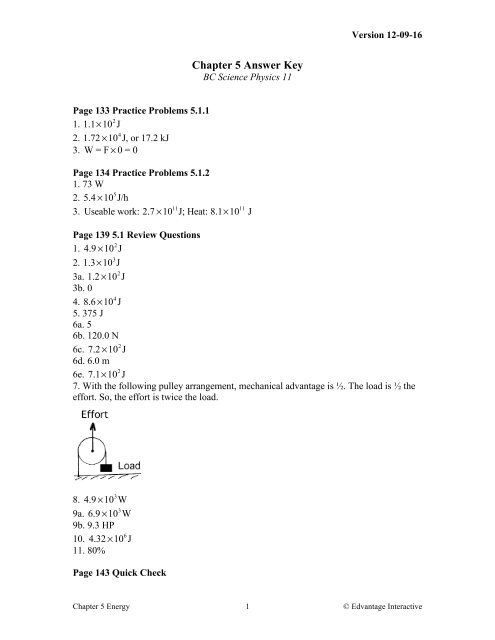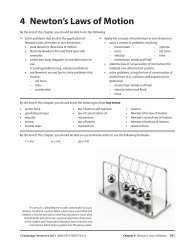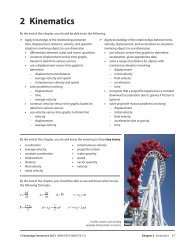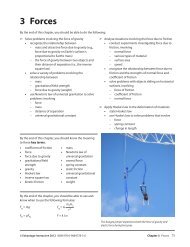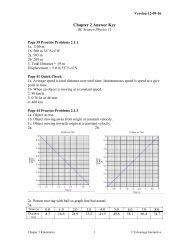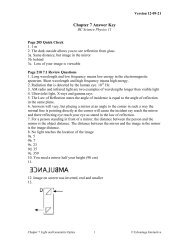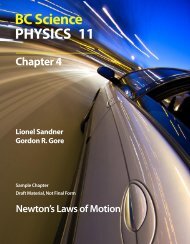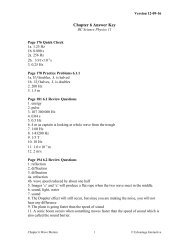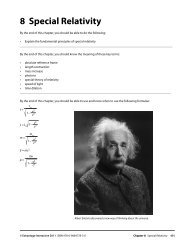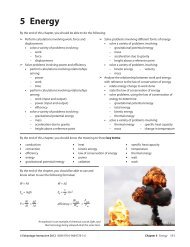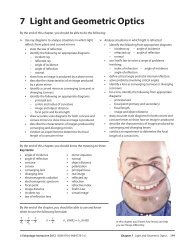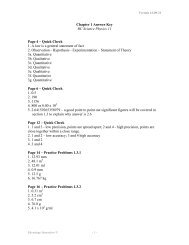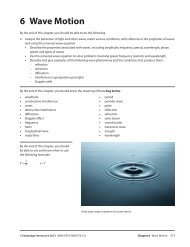Chapter 5 Answer Key - BC Science Physics 11
Chapter 5 Answer Key - BC Science Physics 11
Chapter 5 Answer Key - BC Science Physics 11
Create successful ePaper yourself
Turn your PDF publications into a flip-book with our unique Google optimized e-Paper software.
Page 133 Practice Problems 5.1.1<br />
1. 1.1×10 2 J<br />
2. 1.72 ×10 4 J, or 17.2 kJ<br />
3. W = F × 0 = 0<br />
<strong>Chapter</strong> 5 <strong>Answer</strong> <strong>Key</strong><br />
<strong>BC</strong> <strong>Science</strong> <strong>Physics</strong> <strong>11</strong><br />
Page 134 Practice Problems 5.1.2<br />
1. 73 W<br />
2. 5.4 ×10 5 J/h<br />
3. Useable work: 2.7 ×10 <strong>11</strong> J; Heat: 8.1×10 <strong>11</strong> J<br />
Page 139 5.1 Review Questions<br />
1. 4.9 ×10 2 J<br />
Version 12-09-16<br />
2. 1.3×10 3 J<br />
3a. 1.2 ×10 2 J<br />
3b. 0<br />
4. 8.6 ×10 4 J<br />
5. 375 J<br />
6a. 5<br />
6b. 120.0 N<br />
6c. 7.2 ×10 2 J<br />
6d. 6.0 m<br />
6e. 7.1×10 2 J<br />
7. With the following pulley arrangement, mechanical advantage is ½. The load is ½ the<br />
effort. So, the effort is twice the load.<br />
8. 4.9 ×10 3 W<br />
9a. 6.9 ×10 3 W<br />
9b. 9.3 HP<br />
10. 4.32 ×10 6 J<br />
<strong>11</strong>. 80%<br />
Page 143 Quick Check<br />
<strong>Chapter</strong> 5 Energy 1 © Edvantage Interactive
Version 12-09-16<br />
1. Doubling mass will double kinetic energy, but doubling speed will quadruple kinetic<br />
energy.<br />
2. 4.19 ×10 4 J<br />
3. 1.8 ×10 5 J<br />
4. 7.2 ×10 −2 J<br />
Page 144 Quick Check<br />
1. Potential energy doubles<br />
2. 25.3 kg<br />
3. 6.12 m<br />
Page 147 Practice Problems 5.2.1<br />
1. 7.67 m/s<br />
2. 31.9 m<br />
3. 5.10 m<br />
Page 148 5.2 Review Questions<br />
1. 3.14 ×10 4 J<br />
2a. 4.4 ×10 5 J<br />
2b. 750 m<br />
3. 1.63 m/s 2<br />
4. 7.41 m/s<br />
5a. 2.0 ×10 2 J<br />
5b. 0.31 m<br />
6a. 20% lost<br />
6b. Heat, sound, friction energy loses account for energy lost<br />
7. 3.8 ×10 3 J<br />
8a. 5.2 J<br />
8b. Force is not constant as spring compresses. Average force identifies the assumption<br />
of constant force is being used.<br />
Page 151 Quick Check<br />
1a. Temperature is the average translational kinetic energy of all molecules in a material.<br />
Thermal energy is the total energy of all molecules in an amount of material. Heat is the<br />
amount of thermal energy transferred between one material to another.<br />
1b. Heat refers to transfer of thermal energy. A body contains thermal energy.<br />
2a. 293 K<br />
2b. 586 K; 313 o C<br />
3a. water<br />
3b. nail<br />
3c. nail loses heat to water<br />
3d. water; neither<br />
Page 154 Quick Check<br />
<strong>Chapter</strong> 5 Energy 2 © Edvantage Interactive
Version 12-09-16<br />
1. convection<br />
2a. breeze toward shore<br />
2b. breeze away from shore<br />
2c. early morning breeze goes out to sea<br />
3. Vacuum stops conduction, convection. Silvered walls reflect radiant heat back into the<br />
bottle. Rubber or plastic stopper slows heat transfer by all three methods.<br />
4. Dirty snow absorbs more radiant heat.<br />
Page 159 5.3 Review Questions<br />
1. translational, rotational and vibrational<br />
2. 303 K<br />
3. radiation<br />
4. from 2 to 1, and from 3 to 4<br />
5. body heat is reflected back to the body. Hypothermia victims require warming from the<br />
outside, and the suit prevents this.<br />
6. radiation<br />
7. convection<br />
8. metal blades conduct thermal energy away faster.<br />
Page 161 Practice Problems 5.4.1<br />
1. 2.3×10 7 J<br />
2. 39 o C<br />
3. 4.0 ×10 6 J<br />
4. Water has a very high specific heat capacity<br />
5. c = 3.9 ×10 2 J/kg/C<br />
Page 163 Practice Problems 5.4.2<br />
1. 90%<br />
2. 960 W<br />
3. 3.0 W<br />
4. 12% efficient<br />
Page 165 5.4 Review Questions<br />
1. 5.0 ×10 4 J<br />
2. 1.5×10 5 J<br />
3. 1.47 ×10 5 J<br />
4. 14.7 MJ<br />
5. 200 J/kg/C<br />
6a. 0.0455 C/s<br />
6b. 95.6 W<br />
6c. 100 W<br />
7. Higher specific heat capacity of water means ocean water helps moderates temperature<br />
8. Three times as much light is emitted by the fluorescent light bulb<br />
9. 90%<br />
<strong>Chapter</strong> 5 Energy 3 © Edvantage Interactive
Page 167 <strong>Chapter</strong> 5 Review Questions<br />
1a. 9.86 J<br />
1b. 0<br />
2. 126 J<br />
3. Same amount of work both ways<br />
4a. 4<br />
4b. 60 N<br />
4c. <strong>11</strong>.2<br />
4d. 4.2 ×10 2 W<br />
5a. 12<br />
5b. 2.40 m<br />
5c. 168 J<br />
5d. 168 J<br />
6. 3.6 ×10 6 J/s<br />
7. 20 kJ<br />
8. 3Ek<br />
9. 17 cm<br />
10. 20 cm<br />
<strong>11</strong>. 9.9 m/s<br />
12. 523 K<br />
13. 323 o C<br />
14. Metal a good conductor of thermal energy<br />
15a. convection<br />
15b. conduction<br />
15c. radiation/conduction<br />
16. convection. Warm water is less dense than cold water<br />
17. Water gives off 10 times as much heat.<br />
18. approximate 36 o C<br />
19. 720 kJ<br />
20. 93%<br />
Page 171 <strong>Chapter</strong> 5 Extra Practice<br />
1.<br />
2a.<br />
2b.<br />
3.<br />
4.<br />
5.<br />
6a.<br />
6b.<br />
6c.<br />
6d.<br />
6e.<br />
7a.<br />
7b.<br />
Version 12-09-16<br />
<strong>Chapter</strong> 5 Energy 4 © Edvantage Interactive
8a.<br />
8b.<br />
9.<br />
10.<br />
<strong>11</strong>.<br />
12.<br />
13.<br />
14a.<br />
14b.<br />
14c.<br />
14d.<br />
14e.<br />
15.<br />
16.<br />
17.<br />
18.<br />
19.<br />
20.<br />
21.<br />
22.<br />
23.<br />
24<br />
Version 12-09-16<br />
<strong>Chapter</strong> 5 Energy 5 © Edvantage Interactive


